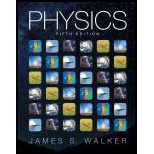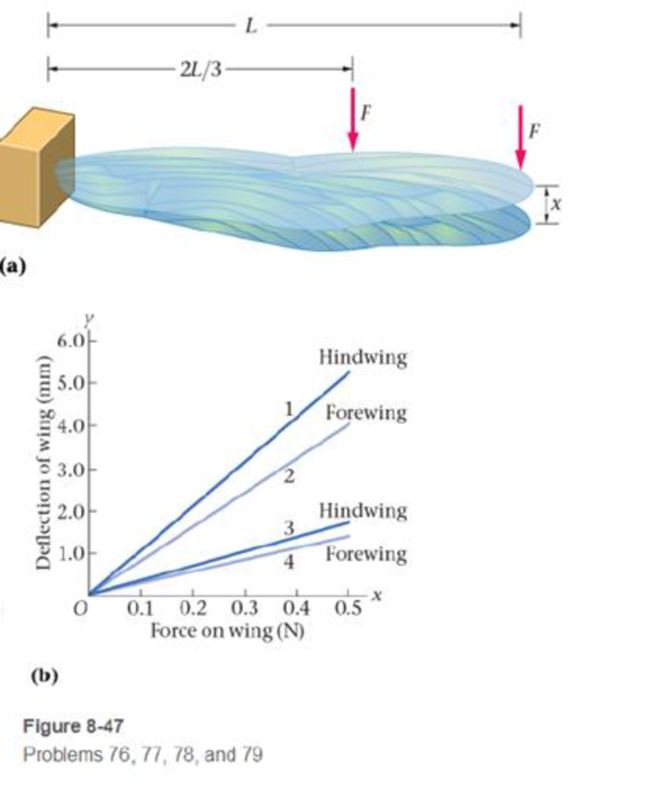
BIO The Flight of the Dragonflies
Of all the animals you’re likely to see on a summer day, the most ancient is the dragonfly. In fact, the fossil record for dragonflies extends back over 250 million years, more than twice as long as for birds. Ancient dragonflies could be as large as a hawk, and were surely buzzing around the heads of both T. Rex and Triceratops.
Dragonflies belong to the order Odonata (“toothed jaws”) and the suborder Anisoptera (“different wings”), a reference to the fact that their hindwings are wider front-to-back than their forewings. (Damselflies. in contrast, have forewings and hindwings that are the same width ) Although ancient in their lineage, dragonflies are among the fastest flying and most acrobatic of all insects; some of their maneuvers subject them to accelerations as great as 20g.
The properties of dragonfly wings, and how they account for such speed and mobility, have been of great interest to biologists Figure 8-47 (a) shows an experimental setup designed to measure the force constant of Plexiglas models of wings, which are used in wind tunnel tests A downward force is applied to the model wing at the tip (1 for hindwing, 2 for forewing) or at two-thirds the distance to the tip (3 for hindwing, 4 for forewing). As the force is varied in magnitude, the resulting deflection of the wing is measured The results are shown in Figure 8-47 (b) Notice that significant differences are seen between the hindwings and forewings, as one might expect from their different shapes.

76. • Treating the model wing as an ideal spring what is the force constant of the hindwing when a force is applied to its tip?
- A. 94 N/m
- B. 130 N/m
- C. 290 N/m
- D. 330 N/m
Want to see the full answer?
Check out a sample textbook solution
Chapter 8 Solutions
EBK PHYSICS
Additional Science Textbook Solutions
Microbiology with Diseases by Body System (5th Edition)
Human Physiology: An Integrated Approach (8th Edition)
Concepts of Genetics (12th Edition)
Physics for Scientists and Engineers: A Strategic Approach, Vol. 1 (Chs 1-21) (4th Edition)
Campbell Biology (11th Edition)
Organic Chemistry (8th Edition)
- SARET CRKS AUTOWAY 12. A stone is dropped from the top of a cliff. It is seen to hit the ground below after 3.55 s. How high is the cliff? 13. A ball is dropped from rest at the top of a building that is 320 m tall. Assuming no air resistance, what is the speed of the ball just before it strikes the ground? 14. Estimate (a) how long it took King Kong to fall straight down from the top of the Empire State Building (280m high), and (b) his velocity just before "landing". Useful equations For Constant Velocity: V => D X = V₁t + Xo For Constant Acceleration: Vr = V + at X = Xo+Vot + v=V+2a(X-Xo) \prom = V +V V velocity t = time D Distance X = Final Position Xo Initial Position V = Final Velocity Vo Initial Velocity a = acceleration For free fall Yf = Final Position Yo Initial Position g = 9.80 m $2 For free fall: V = V + gt Y=Yo+Vo t + +gt V,² = V₁²+2g (Y-Yo) V+Vo Vprom= 2 6arrow_forwardSolve the problemsarrow_forwardA 11 kg weight is attached to a spring with constant k = 99 N/m and subjected to an external force F(t) =-704 sin(5t). The weight is initially displaced 4 meters above equilibrium and given an upward velocity of 5 m/s. Find its displacement for t> 0. y(t) וןarrow_forward
- 7. A race car accelerates from rest to 55 m s-1 in 5.0 seconds. The acceleration of the car Is m s-² 8. An object's speed increases uniformly from 10.5 km per hour to 99.8 km per hour in 2.41 seconds. Calculate the acceleration in m s-2 and express your answer to three significant figures. 9. The acceleration-time graph of a car is shown below. The initial speed of the car is 5.0 m s-1. # Acceleration (ms) 12 8.0- 4.0- 2.0 4.0 6.0 Time (s) Calculate the velocity of the car at t = 4.0 s. 3arrow_forwardNo chatgpt pls will upvotearrow_forwardNo chatgpt pls will upvotearrow_forward
- Problem Seven. A football receiver running straight downfield at 5.60 m/s is 11.5 m in front of the quarterback when a pass is thrown downfield at an angle of 35.0° horizon. above the 8.) If the receiver never changes speed and the ball is caught at the same height from which it was thrown, find the distance between the quarterback and the receiver when the catch is made. (A) 21.3 (B) 17.8 (C) 18.8 (D) 19.9 (E) 67.5arrow_forwardPlease solve and answer the question correctly please. Thank you!!arrow_forwardPlease solve and answer the question correctly please. Thank you!!arrow_forward
- Please view both photos, and answer the question correctly please. Thank you!!arrow_forwardA thrown brick hits a window, but doesn't break it. Instead it reverses direction and ends down on the ground below the window. Since the brick didn't break the glass, we know: О The force of the brick on the glass > the force of the glass on the brick. О The force of the brick on the glass the force of the glass on the brick. = О The force of the brick on the glass < the force of the glass on the brick. О The brick didn't slow down as it broke the glass.arrow_forwardAlexandra (wearing rubber boots for traction) is attempting to drag her 32.6-kg Golden Retriever across the smooth ice by applying a horizontal force. What force must she apply to move the dog with a constant speed of 0.950 m/s? ☐ 31.0 lb. ☐ 319 kg. ○ Zero. 32.6 kg.arrow_forward
 College PhysicsPhysicsISBN:9781285737027Author:Raymond A. Serway, Chris VuillePublisher:Cengage Learning
College PhysicsPhysicsISBN:9781285737027Author:Raymond A. Serway, Chris VuillePublisher:Cengage Learning Physics for Scientists and EngineersPhysicsISBN:9781337553278Author:Raymond A. Serway, John W. JewettPublisher:Cengage Learning
Physics for Scientists and EngineersPhysicsISBN:9781337553278Author:Raymond A. Serway, John W. JewettPublisher:Cengage Learning Physics for Scientists and Engineers with Modern ...PhysicsISBN:9781337553292Author:Raymond A. Serway, John W. JewettPublisher:Cengage Learning
Physics for Scientists and Engineers with Modern ...PhysicsISBN:9781337553292Author:Raymond A. Serway, John W. JewettPublisher:Cengage Learning Physics for Scientists and Engineers: Foundations...PhysicsISBN:9781133939146Author:Katz, Debora M.Publisher:Cengage Learning
Physics for Scientists and Engineers: Foundations...PhysicsISBN:9781133939146Author:Katz, Debora M.Publisher:Cengage Learning College PhysicsPhysicsISBN:9781938168000Author:Paul Peter Urone, Roger HinrichsPublisher:OpenStax College
College PhysicsPhysicsISBN:9781938168000Author:Paul Peter Urone, Roger HinrichsPublisher:OpenStax College University Physics Volume 1PhysicsISBN:9781938168277Author:William Moebs, Samuel J. Ling, Jeff SannyPublisher:OpenStax - Rice University
University Physics Volume 1PhysicsISBN:9781938168277Author:William Moebs, Samuel J. Ling, Jeff SannyPublisher:OpenStax - Rice University





